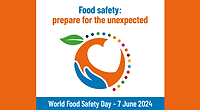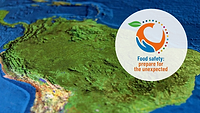Remarks from the FDA on World Food Safety Day: "Food Safety is Everyone's Business"

Statement From:
Deputy Commissioner for Food Policy and Response - Food and Drug Administration
Frank Yiannas
This first World Food Safety Day is a recognition that when it comes to food safety, we all win or lose together. In a global food system and with the increase in international travel, if foodborne disease exists somewhere in the world, it can exist anywhere in the world. No nation stands alone when faced with the challenge of protecting its citizens from foodborne illnesses. This truth is reflected in the theme of this inaugural event: “Food Safety Is Everyone’s Business.”
I am honored to be representing the U.S. Food and Drug Administration today. This is a wonderful opportunity to talk about the importance of food safety and how we can work together to improve quality of life for people in every nation. But first I would like to acknowledge and thank the Food and Agriculture Organization of the United Nations (FAO) and the World Health Organization (WHO) for all that they do to advance food safety worldwide.
Food safety is an issue that transcends international borders. Foodborne pathogens do not recognize boundaries or borders, so when it comes to protecting consumers, neither should we. It’s estimated that foodborne illnesses are responsible for 420,000 deaths annually around the world, 125,000 of them in children under age 5. Think about that. It’s not just a sad statistic – it’s a public health call to action. It’s almost twice the estimated deaths in the earthquake that hit Haiti in 2010. It’s roughly 229 times the people who died when Hurricane Katrina hit our Gulf Coast in 2005. In the United States alone, the Centers for Disease Control and Prevention estimates that 3,000 people die each year from foodborne illnesses.
Taking a world view of food safety is important for all consumers because food moves globally, as do we. In the U.S., about 15 percent of the food supply is imported from more than 200 countries or territories, including 32 percent of the fresh vegetables, 55 percent of the fresh fruit and at least 94 percent of the seafood that Americans eat each year. And these statistics are not unique to the U.S. – similar patterns are seen around the world and global movement of foods continues to grow.
The FDA fully supports this united effort to advance the prevention, detection and mitigation of foodborne risks. But this is not something we can do just one day a year; our mission is one that must be carried out every day, anywhere where food is produced, 365 days a year.
To protect the food supply, we must use a variety of tools. Rules, response and compliance activities are common, and critical, tools for food policy makers and regulators. But as nations we must go beyond merely having rules and regulations. We must also foster, support, and strengthen food safety cultures on our farms, in our food facilities, and in our nations. We will not make dramatic improvements in reducing the global burden of foodborne disease without strengthening a culture of food safety and doing more to influence and change human behavior. In fact, I like to say, simply put, food safety equals behavior.
So, what is a food safety culture? It’s patterned ways of thought and behavior that characterize a social group, whether it be a farm, a company, a geographic region, or a nation. Those patterned ways of thought and behavior can be learned through socialization processes and persist through time.
You see, I believe food safety can be caught, not only taught. I also believe that a food safety culture is a prerequisite to an effective food safety management system.
How do we promote food safety culture as public health agencies and organizations? To me, it’s a matter of always thinking and speaking about food safety to food producers and each other about the idea that food safety transcends regulations and borders. It’s the idea that food safety is a belief that all consumers matter, that we care about their safety and the safety of their friends and families. It’s also about being guided by the “why” food safety matters. There are such compelling reasons that whenever we don’t address the “why,” it’s a lost opportunity.
Why are we doing this? Because consumers deserve to be confident in the safety of the food supply. Because farmers and food manufacturers want their customers, as well as their business, to thrive. But most importantly: Because too many of our citizens are still getting sick and dying of foodborne illness – and we can do better. No, we MUST do better.
As we look towards the future, there’s no question that we must all continue to work on creating a stronger, global culture of food safety, together.
At FDA, our work towards this goal is set in the framework of three missions set forth by Congress and FDA to prevent foodborne illnesses, create a modern food safety system, and empower consumers to make informed choices about their diet.
First, there is the FDA Food Safety Modernization Act (FSMA) that FDA has been implementing since it was signed into law in 2011. Under FSMA, science and risk-based standards have been put in place for the production, packing, holding and transportation of foods. Many of companies that produce our foods – no matter where in the world they are located -- must systematically recognize what hazards may exist and routinely take steps to prevent them.
Second, Acting Commissioner Ned Sharpless and I recently announced an initiative called a New Era of Smarter Food Safety that will leverage new and emerging technologies to further our food safety goals. This is a new approach to food safety, one that explores the use of the technologies being used in society and business sectors all around us, such as blockchain, sensor technology, the Internet of Things, and Artificial Intelligence, to create a more digital, traceable, and safer food system. And one that creates shared value for all stakeholders -- farmers, food producers, regulators, consumers, and the planet.
Third, there’s FDA’s Nutrition Innovation Strategy that FDA announced in 2018 to empower consumers with information and facilitate industry innovation to create healthier products, to help combat the growing burden of chronic disease. This strategy includes implementing the updated Nutrition Facts label and requiring that certain menus and vending machine labels include calorie information. These are just two of the ways in which FDA is helping consumers find the information they need to make healthful food choices.
In closing, I look forward to discussing how we can work together as the citizens of all nations, large and small, to ensure that everyone has access to safe, affordable, and healthful foods.
There’s a role for everyone in this important work. A World Food Safety Day page at fda.gov has valuable information about how to participate in spreading the word about food safety and what you can do to avoid foodborne illnesses.
No matter where we live or where we work, we’re all serving the same boss. The consumer. So, let’s get to work, because they’re counting on us and food safety is everyone’s business, 365 days a year.
Looking for a reprint of this article?
From high-res PDFs to custom plaques, order your copy today!








